 2nd class Destroyers built 1921-23, N°2 to 26, 5 cancelled, renamed 1928: Wakatake, Kuretake, Sanae, Sawarabi, Asagao, Yūgao, Fuyō, Karukaya
2nd class Destroyers built 1921-23, N°2 to 26, 5 cancelled, renamed 1928: Wakatake, Kuretake, Sanae, Sawarabi, Asagao, Yūgao, Fuyō, KarukayaThe Wakatake-class were decond class destroyers and follow-on to the Momi class as part of Japan’s 8-6 Fleet Program, FY1921. They were to complement the larger Minekaze and Kamikaze class destroyers. Thirteen were ordered in 1919 but due to the Washington Naval Treaty and budgetary limitations, the last four were cancelled in 1922, leaving eight as No.14 was also cancelled. These were also the last “second class” destroyers of the IJN as it was decided later to stick to a single, larger standard. The Wakatake-class were to have names, but were completed with numbers. This decision was extremely unpopular with crews and by 1928 names were reassigned. They were used, like the previous Momi class, as escorts in the Sino Japanese war from 1937 and as as well in WW2, with some reconverted as patrol boats. Losses were heavy in the Pacific, none survived, all were sunk in action apart N°8/Sawarabi, lost in a storm off Taiwain in 1932.

Development
Context and Genesis
Prior to the first word war, the Imperial Japanese Navy ordered her destroyers to British yards with a few extra ones gained as prizes after the 1894 war with China and 1905 Russo-Japanese War as well as a few after WW1 as well. All these gave a valuable sampling of naval construction for destroyers at the time. This study as well as of methods and techniques plus, more ditect knowledge gained from destroyers built under licensing agreements and expanding buiding capacity accompanied experience. Eventually it was reasonable to have in 1918 a serie of Japanese designed and buolt destroyers, picking up elements in all designs, creating a synthesis of best features. In 1916 already the Navy issued specifications for 1st and 2nd Class destroyers having different role, fleet destroyers to escort capital ships and cruisers, and the others for coastal defence and protect home waters as well as escorting convoys. The frst generation were the Minekaze and Momi classes respectively. Only in appearance they seemed leaned towards German designs.
Next the second generation was ordered, comprising the first class Kamikaze (or Shiokaze), and the second class Wakatake class. These medium-sized vessels were essentially a follow-on to the Momi class with twele initially planned as part of the 8-6 Fleet Program from, fiscal yard 1921, low cost complement to the large Minekaze-class. The thirteen vessels were reduced to nine due to the Washington Naval Treaty signed by Japan and capping destroyer tonnage in 1922. Then No.14 was also cancelled for budgetary reasons. Later, N°8 was lost in a storm and no longer available in 1941, leaving seven ships in class.
The Wakatake class were the last of the “second class” as the admiralty juged that they were redundant, most foreign navies creating standard destroyers with fewer destroyer leaders when the need arose. Future destroyers such as the Kamikaze and especially the Mutsuki would be standardized.
Construction
It was sprtead out between many more yards than 1st class destroyers, with manyt more orders expected, which is why numbers were chosen.
Builders:
Maizuru Naval Arsenal: Wakatake
Kawasaki Shipyards: Kuretake
Uraga dock Shipyards: Sanae, Sawarabi
Ishikawajima Shipyards: Asagao, Yūgao
Fujinata Shipyards: Fuyō, Karukaya
Names
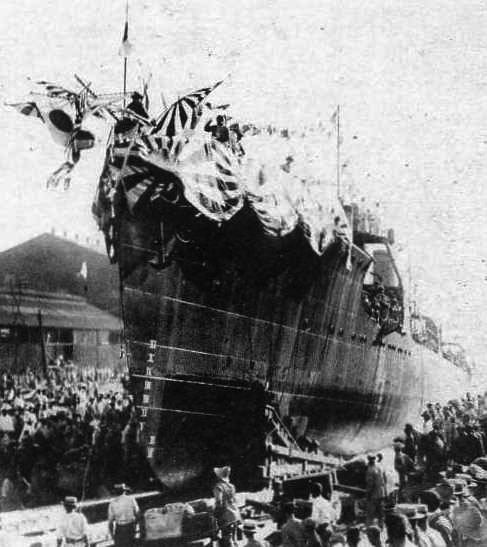
The admiralty also decided that these second class destroyers should be assimilated to former torpedo boats and have numbers instead of names. It was indeed theorized, under the projected Eight-eight fleet plan to have so many warships build as to empty the possible array of names. However this was tested in operation after completion in 1922-23 and soon it appeared a bad decision. With only numbers this became confusing for command and control, brought confusion in communications. More so, the crews hated this decision. Captains reported this was extremely unpopular ad this did not brough a sense of pride and esprit de corps. Sailors saw themselves as “second class sailors” and that sens of image was important culturally back then. In 1928 at last, the IJN staff reverted this decision. By August 1928 names were assigned, but not the original ones planned. The are detailed in the career of the ships later.
2nd class destroyers such as the Momi class were named after… plants (ex. chestnut, wisteria, reed, lotus, violet).
Later in the interwar years, destroyers were allocated names associated with other natural phenomena of weather, sky and sea, like the snow (-yuki), rain (-ame), clouds (-kumo), waves (-nami), mist (-kiri), frost (-shimo), tides (-shio), and the moon (-tsuki).
Wakatake (ex-No.2) was originally Kikyō (Chinese bellflower) Dai-2-Gō Kuchikukan or No.2 Destroyer Wakatake (Bamboo sprout)
Yuri in 1928 was (Lilium), 4th Destroyer or Dai-4-Gō Kuchikukan, No.4 Destroyer and Kuretake orginally (Black bamboo).
Ayame in 1928 (Iris) was the 6th Destroyer or Dai-6-Gō Kuchikukan or Sanae (Rice sprouts on May) originally
Kaidō (Malus halliana) was the 8th destroyer or Dai-8-Gō Kuchikukan, originally Sawarabi (Bracken on Spring).
Kakitsubata (Iris laevigata) was the 10th Destroyer or Dai-10-Gō Kuchikukan, originally Asagao (Morning glory).
Tsutsuji (Azalea) was the 12th Destroyer (Dai-12-Gō Kuchikukan), originally Yūgao (Ipomoea alba).
IJN Shion (Aster tataricus) was the 14th Destroyer, cancelled 1922.
Ajisai (Hydrangea) was the 16th Destroyer and originally Fuyō (Hibiscus mutabilis)
Karukaya (Poaceae) was the 18th Destroyer, oriignally Karukaya (Andropogoneae grass for thatching).
Omodaka (Alismataceae) was the 20th Destroyer, cancelled 1922.
Botan (Peony) was the 22nd Destroyer, cancelled 1922.
Bashō (Musa basjoo) was the 24th Destroyer, cancelled 1922.
Nadeshiko (Dianthus) was the 26th Destroyer, cancelled 1922.
This left the former N°2, 4, 6, 8, 10, 12, 16 and 18 active.
Design of the class
The Wakatake-class were essentially slightly modified Momi-class vessels. Designers since 1919 made the design some omprovements and the hull was 50 tons heavier in displacement with a deeper draft to improve handling characteristics in heavy seas and combat rolling, one critic from earlier designs and typical of narrow destroyers. The Weaponry layout as well as general arrangement and silhouette were all the same overall.
Hull and general design
The Wakatake class displaced 900 long tons (914 t) at normal load and 1,100 long tons (1,118 t) fully loaded. They measured 83.8 m (275 ft) between parallels, and 85.3 m (280 ft) overall for a beam of 7.9 m (26 ft) and larger draught at 2.5 m (8.2 ft) instead of 2.4 m (8 ft). The general shape was strickly identical, with the typical hull cut forward where was located the first torpedo tubes bank, with another on the aft deck. They were basically shortened first class DDs with four main guns instead of five and two triple TT banks instead of three triple. Armament was standard and unchanged until the Fubuki “specials” from 1926.
Powerplant
Steam turbines were used for propulsion and Asagao had Parsons impulse turbines, Yūgao had Escher Wyss & Cie Zoelly turbines, all the reste were completed with Brown-Curtis turbines. This was for comparative tests. The Momi class indeed had Parsons steam turbines. They were fed by three Kampon heavy oil-fired boilers for a tota of 21,500 ihp (16,000 kW). As for performances, they were the same as the Momi class, 36 knots (67 km/h) top speed, light load, and a Range of 3,000 nmi (5,600 km) at 15 knots (28 km/h; 17 mph) based on 244 tons of fuel oil. In practrice they rarely ventured beyond 35.5 knots in service max.
Armament
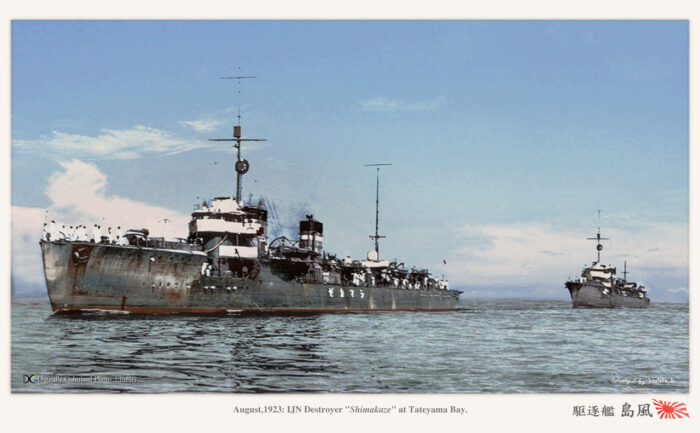
Shimakaze in Tateyama Bay in 1932, colorized by Irotoko Jr.
In brief:
-4 × 12 cm/45 (4.7 inch) type 3 naval guns in single mounts, shielded, one forward, one aft, one amidships on a bandstand.
-6x 533 mm (21 inch) torpedo tubes in three twin mounts, one forward in the hull break well, two aft.
-Two 7.7mm/80 Type 92 light AA machine guns src
-20 mines and a mechanical minesweeping gear.
-Depth charges for anti-submarine warfare, see notes.
Their armament was identical to that of the Momi class, same battery of three Type 3 120 mm 45 caliber naval guns in single mounts (forcastle, stern structure, amidship bandstand), and two twin Type 6 torpedo launchers. Anti-aircraft protection was limited at the time to two 7.7mm machine guns.
12 cm/45 3rd Year Type naval gun
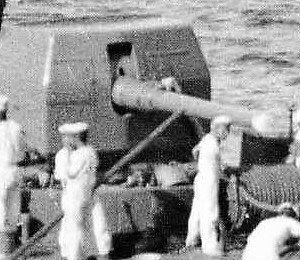 The 12 cm/45 gun was designed in 1895 as an indigenous variant of an Elswick Ordnance Pattern Y under the designation “Type 41”. In 1921 it was declined into an high-angle AA gun, the 12 cm/45 10th Year Type. The base model had a Single motion interrupted screw Welin breech block different from the Type 3 12 cm AA Gun used by the Army in 1943. On destroyers it was always shielded (photo), with the latter fitted with two opening panels.
The 12 cm/45 gun was designed in 1895 as an indigenous variant of an Elswick Ordnance Pattern Y under the designation “Type 41”. In 1921 it was declined into an high-angle AA gun, the 12 cm/45 10th Year Type. The base model had a Single motion interrupted screw Welin breech block different from the Type 3 12 cm AA Gun used by the Army in 1943. On destroyers it was always shielded (photo), with the latter fitted with two opening panels.
From 1922 the gun evolved into the 12 cm 11th Year Type naval gun (Model 1922) with a shorter gun barrel and horizontal sliding breech-block but reserved for TBs and submarines only. Manually loaded it fired a 20.3 kg (45 lb) high-explosive or illumination shell. The patrol conversions from 1943 also received an anti-submarine shell.
Thuis gun was ubiquitous for early IJN destroyers, also found on the Momi, Kawakaze, Minekaze, Mutsuki, Wakatake class destroyer as well as the Chidori/Erotofu class TBs and the Shimushu and Tsukushi class escort/survey ships of the Hashidate class gunboats.
⚙ specifications 12 cm/45 3rd Year |
|
| Weight | 3,240 kg (7,140 lb) |
| Barrel length | 5.4 m (18 ft) bore |
| Elevation/Traverse | -7° +33° and 120°/120° |
| Loading system | Welin breech block, Hydro-pneumatic recoil |
| Muzzle velocity | 825 m/s (2,710 ft/s) |
| Range | 16 km (10 mi) at 33° |
| Crew | 6 |
| Round | 20.3 kg (45 lb) 120 x 550 mm.R., sep. loading cased charge |
| Rate of Fire | 5–6 rpm |
As for torpedoes, these ships had access to a wide variety of 533 mm models, the 21″ (53.3 cm) Type 43 and Type 44 No. 1/2 1911 models, and were certainly planned with the Type 6 (1917) which entered service in 1918, with the first ships completed in late 1919 and the last in 1922.
Type 6 (1917)
Initially planned for battlecruisers and battleships of the “8-8-8” plan, later cancelled with the Washington treaty. Standard 43 cm torpedo for new cruisers and destroyers when metric was used also for these models.
⚙ specifications Type 6 |
|
| Weight | 3,157 lbs. (1,432 kg) |
| Dimensions | 269 in (6.84 m) |
| Propulsion | Kerosene-air wet-heater |
| Range/speed setting | 7,000 m/35, 10,000m/32, 15,000m/26 knots |
| Warhead | 448 lbs. (203 kg) Shimose |
| Guidance | Straight course |
Depth Charges
Standard Type 95, 30.5″ by 17.7″ (77.5cm by 45cm). 220 lb (100 kg) charge, Type 88 explosive (ammonium perchlorate and ferrosilicate). Fuse using a water inlet. 100 feet (30m) and 200 feet (60m) settings (after the revelations of a US Congressman).
Later increased to 324 lb (147kg), Type 97 explosive (70% TNA/30% HNDA), 300 foot (90m) setting.
-1944 Type 2: 230 lbs (105kg) Type 97 explosive settings 98, 197, 292, 390, 480 feet (30m, 60m, 89m, 120m, and 145m).
-1945 Type 2: 357 lbs (162kg) explosives.
Mines
20 mines on rails, no precision given. Can be any of the models here.
Modernizations of WW2
From 1942 of of their Type 3 guns was replaced by two triple-mount Type 96 25-mm cannons or combinations of three twin-mounts and two single-mounts. The minesweeping gear was replaced by 36 to 48 depth charges and four launchers as well. The few survivors that made it to 1943 received a Type 13 radar and a better sonar.
In 1938 already, stability limitations led to reinforce IJN Wakatake and Sanae, adding a solid ballast for a standard displacement ported to 1131t and top speed down to 31kts.
In 1940, Yugao was the first converted as a patrol escort: One boiler removed, top speed 18kts based on 10,000hp, displacement 930/1130t normal. She lost her rear 120mm/45, and LMGs ans well as her two TT banks and mines rail and minesweeping gear. In exchange she received four twin 25mm/60 Type 96 AA guns, four Depth charge throwers and two racks at the stern for 60 DCs total and a type 93. sonar.
In 1941-1942, Wakatake, Kuretake, Sanae, Fuyo, Karukaya underwent a similar rearmament, ending with two main guns, two triple type 96 25mm/60 AA mount plus four single 13.2mm/76 HMGs AA and four DCT (48 DCs) and the type 93 sonar, Asagao being converted the same later in 1942.
1944 survivors received the Type 3 model 1 radar.
Sensors (WW2)
93-shiki (Type 93) sonar (1943):2 kW 4400 lbs (2000 kg) model, FRQ 17.5 kHz, receiver gain 120 decibels 2, 4, or 8 seconds pulse interval, range up to 1640-3300-6600 yards (1500m-3000m-6000m) at 3°/10° resolution.
3-shiki (Type 3) 1-go radar: Surviving destroyers in 1944. 2 arrays of 5 dipoles, 10 kW, wlg 20, PRF 500, range 150 km effective, 300 km max.

IJN Harukaze in 1939
⚙ specifications |
|
| Displacement | 864 t normal, 1,036 t deep load |
| Dimensions | 85.3 x 7.9 x 2.5m (280 x 26 x 8.2 ft) |
| Propulsion | 2 shafts Brown Curtiss steam turbines, 3 Kampon water-tube boilers 21,500 shp (16,000 kW) |
| Speed | 36 knots (67 km/h; 41 mph) |
| Range | 3,000 nmi (5,600 km; 3,500 mi) at 15 knots (28 km/h; 17 mph) |
| Armament | 3× 12 cm (4.7 in) Type 3 guns, 2×2 53.3 cm (21 in) TTs, see notes |
| Sensors | Type 93 sonar, Type 2 mod 2 radar |
| Crew | 148 |
Career of the Wakatake class
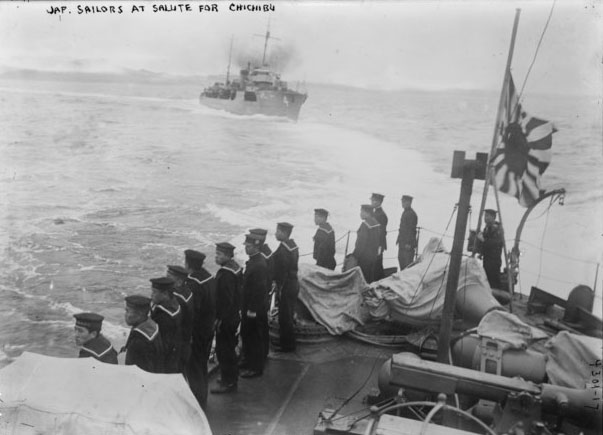
The Imperial Navy wanted to improve commerce protection and on 10 April 1942 was created the 1st Surface Escort Division in the Southwest Area Fleet, for which were assigned Desdivs 13 and 32.
The 13th Destroyer Division comprised WAKATAKE, KURETAKE, SANAE, assigned originally to the Kure Naval District, patrolling waters of the Inland Sea and Bungo Strait, as far as the western Kyushu. The 32th Destroyer Division comprised ASAGAO, FUYO and KARUKAYA assigned originally to Chinkai (Korea) Guard District, screening maritime traffic in the Tsushima Straits
Convoy routes on which they were concentrated were between Japan (Moji), Formosa, and the Philippines, but later as well, Singapore, Indochina as well as the East Indies and Palau. On 10 December 1942 both units disbanded and all six destroyers were placed under direct command of the 1st Surface Escort Division.
Teyr tried to protect the “Southern Resources Area” from preying US Submarine, which presence and efficience only grew over the years. IJN KARUKAYA managed set still a record for 54 convoy escorts before her loss and she was a rare exception. Four were lost to their most expected prey, US submarines. SANAE was sunk in November 1943 by BLUEFISH, FUYO in December 1943 by PUFFER, KARUKAYA in May 1944 by COD and KURETAKE in December 1944 by RAZORBACK while protecting convoys notably in and around the Philippine Islands.
On 30 March 1944 had the lead vessel WAKATAKE at Palau when TF 38 made a devatasting strike. She was trying to escape it but was corner by TBF avengers and sunk eventually by aerial torpedoes while trying to escape the atoll but was confused with Momi, sunk into the atoll in later publications, unveiled by Recent research on the Palau shipwrecks by Dan E. Bailey.
 IJN Wakatake (ex-No.2) (1922)
IJN Wakatake (ex-No.2) (1922)
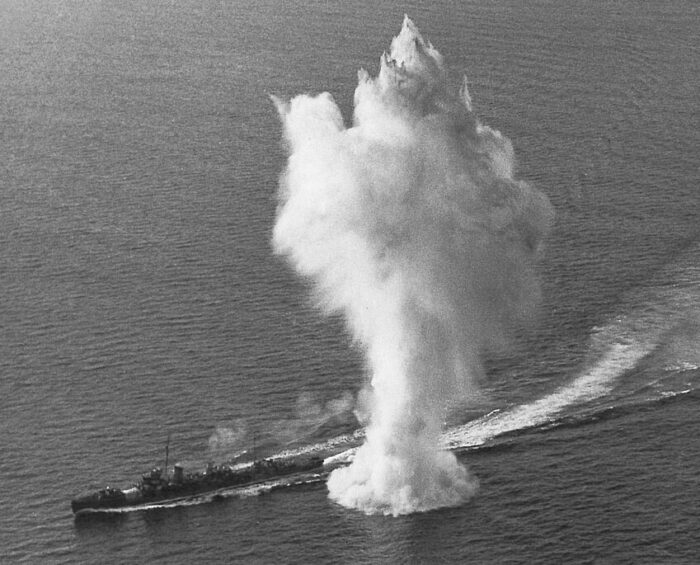
Wakatake was laid down at Kawasaki Shipyards on 13 December 1921, launched on 24 July 1922 and completed on 30 September 1922. She was Sunk in air attack off Palau during Operation Desecrate One on 30 March 1944 and stricken 10 May 1944.
 IJN Kuretake (ex-No.4) (1922)
IJN Kuretake (ex-No.4) (1922)
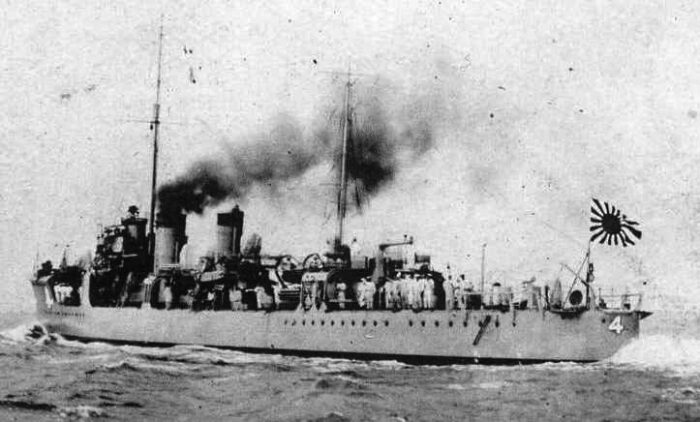
Kuretake was laid down at Maizuru Naval Arsenal on 15 March 1922, launched on 21 October 1922 and completed on 21 December 1922. She was sunk by USS Razorback at Bashi Channel in December 1944 and stricken on 10 February 1945
 IJN Sanae (ex-No.6) (1923)
IJN Sanae (ex-No.6) (1923)
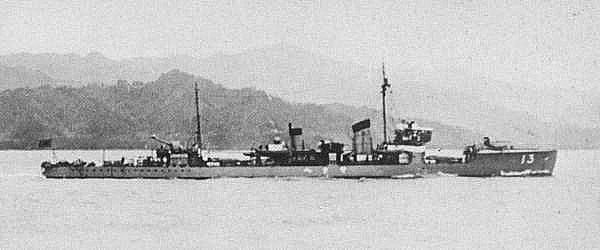
Sanae in 1936
Sanae was laid down at Uraga Dock on 5 April 1922, launched on 15 February 1923 and completed on 5 November 1923. She was torpedoed by USS Bluefish in Celebes Sea on 13 November 1943 and struck on 5 January 1944.
 IJN Sawarabi (ex-No.8) (1923)
IJN Sawarabi (ex-No.8) (1923)
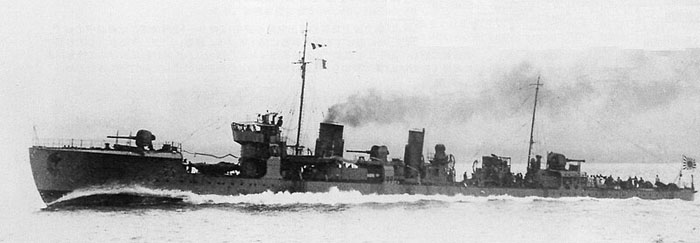
Sawarabi was laid down at Uraga Dock on 20 November 1922, launched on 1 September 1923 and completed on 24 July 1924. She Capsized in storm off Keelung, Taiwan on 5 December 1932, nor recoverable, she was struck 1 April 1933, only one not to take part in WW2 actions. Leaving 7 boats, one converted 1940 as patrol boat, leaving six as “destroyers”.
 IJN Asagao (ex-No.10) (1922)
IJN Asagao (ex-No.10) (1922)

Asagao was built at Ishikawajima Shipyards, laid down on 14 March 1922, launched on 4 November 1922 and completed on 10 May 1923. She protected convoys at Moji, Mako and Takao, Manila, Palau twice, Balikpapan and only met her end when at Camranh Bay with a convoy from Takao in January 1944 as AMATSUKAZE was torpedoed and heavily damaged and she tried to tow her to Cape St. Jacques but esumed activities by February in escort duties with Manila and Hainan. On 9 July 1944 A she was “defeated” by a reef near Hainan in a typhoon, stranded for three months. On 29 July she weathered furious air attacks but toook only light damage. On 15 October 1944 was she refloated, returned to Japan for repairs and returned to escorts by April 1945 off Takao. Due to her age and wear she was kept in the Inland Sea as mother ship for patrol craft and minesweepers. On 22 August she was hit by a wandering airborne mine near Shimonoseki, at the Kanmon Straits. Flooded she was abandoned but later raised and towed to shore and BU in 1948, the last of the 2nd class IJN destroyers.
 IJN Yūgao (ex-No.12) (1923)
IJN Yūgao (ex-No.12) (1923)
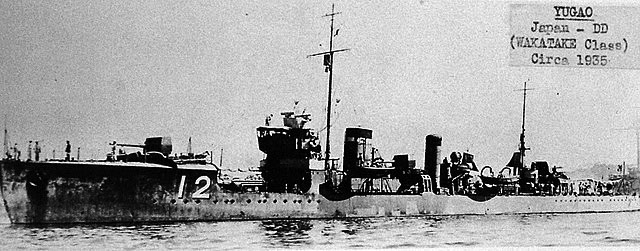
Yugao in ONI page
Yūgao was laid down at Ishikawajima Shipyards on 15 May 1922, launched on 14 April 1923 and completed on 31 May 1924. She was Converted as Patrol Boat No. 46 (Dai-46-Gō shōkaitei) on 1 February 1940 and placed under a separare command from her sisters. She was sunk by USS Greenling at Irōzaki on 10 November 1944.
 IJN Fuyō (ex-No.16) (1922)
IJN Fuyō (ex-No.16) (1922)

N°16 (later Fuyo) in 1923
Fuyō was laid down at Fujinagata Shipyards on 16 February 1922, launched on 23 September 1922 and completed on 16 March 1923. She was torpedoed by USS Puffer off Manila Bay on 20 December 1943 and struck on 5 February 1944.
 IJN Karukaya (ex-No.18) (1923)
IJN Karukaya (ex-No.18) (1923)
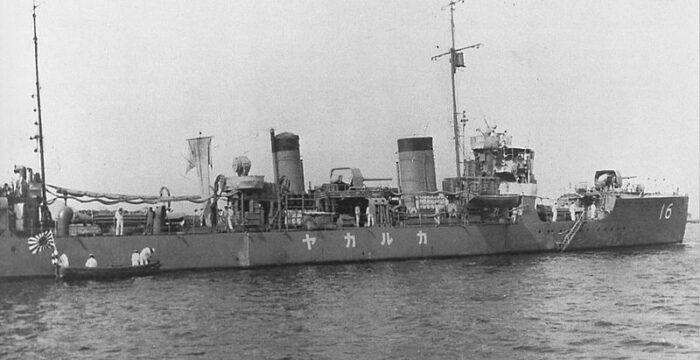
Karukaya in China 1937
Karukaya was also from Fujinagata Shipyards, laid down on 16 May 1922, launched on 19 March 1923 and completed on 20 August 1923. She was torpedoed by USS Cod west of Luzon on 10 May 1944 and stricken on 10 July 1944.
Read More/Src
Books
Evans, David (1979). Kaigun: Strategy, Tactics, and Technology in the Imperial Japanese Navy, 1887–1941. NIP
Howarth, Stephen (1983). The Fighting Ships of the Rising Sun: The Drama of the Imperial Japanese Navy, 1895–1945. Atheneum.
Jentsura, Hansgeorg (1976). Warships of the Imperial Japanese Navy, 1869–1945. NIP
Watts, A.J. (1966). Japanese warships of World War II. Ian Allan.
Collection of writings by Sizuo Fukui Vol.5, Stories of Japanese Destroyers, Kōjinsha (Japan) 1993.
Model Art Ship Modelling Special No.17, Genealogy of Japanese Destroyers Part-1, Model Art Co. Ltd. (Japan), September 2005
Model Art Extra No.340, Drawings of Imperial Japanese Naval Vessels Part-1, Model Art Co. Ltd. (Japan), October 1989
Daiji Katagiri, Ship Name Chronicles of the Imperial Japanese Navy Combined Fleet, Kōjinsha (Japan), June 1988
Links
on combinedfleet.com Wakatake_t.htm
on combinedfleet.com – service
on admiral31.world.coocan.jp/
pwencycl.kgbudge.com/
on globalsecurity.org/
on en.wikipedia.org/
on armedconflicts.com/
coatneyhistory.com/

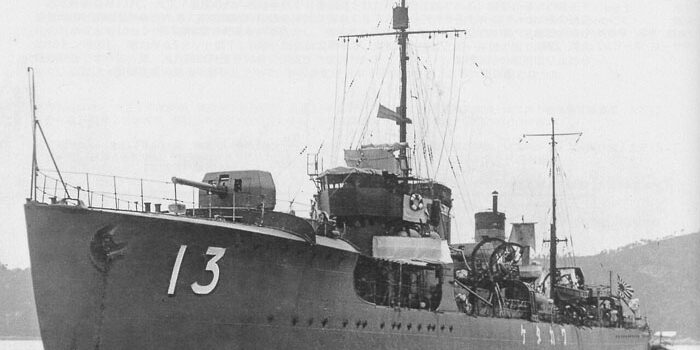
 Latest Facebook Entry -
Latest Facebook Entry -  X(Tweeter) Naval Encyclopedia's deck archive
X(Tweeter) Naval Encyclopedia's deck archive Instagram (@navalencyc)
Instagram (@navalencyc)





 French Navy
French Navy Royal Navy
Royal Navy Russian Navy
Russian Navy Armada Espanola
Armada Espanola Austrian Navy
Austrian Navy K.u.K. Kriegsmarine
K.u.K. Kriegsmarine Dansk Marine
Dansk Marine Nautiko Hellenon
Nautiko Hellenon Koninklije Marine 1870
Koninklije Marine 1870 Marinha do Brasil
Marinha do Brasil Osmanlı Donanması
Osmanlı Donanması Marina Do Peru
Marina Do Peru Marinha do Portugal
Marinha do Portugal Regia Marina 1870
Regia Marina 1870 Nihhon Kaigun 1870
Nihhon Kaigun 1870 Preußische Marine 1870
Preußische Marine 1870 Russkiy Flot 1870
Russkiy Flot 1870 Svenska marinen
Svenska marinen Søværnet
Søværnet Union Navy
Union Navy Confederate Navy
Confederate Navy Armada de Argentina
Armada de Argentina Imperial Chinese Navy
Imperial Chinese Navy Marinha do Portugal
Marinha do Portugal Mexico
Mexico Kaiserliche Marine
Kaiserliche Marine 1898 US Navy
1898 US Navy Sovietskiy Flot
Sovietskiy Flot Royal Canadian Navy
Royal Canadian Navy Royal Australian Navy
Royal Australian Navy RNZN Fleet
RNZN Fleet Chinese Navy 1937
Chinese Navy 1937 Kriegsmarine
Kriegsmarine Chilean Navy
Chilean Navy Danish Navy
Danish Navy Finnish Navy
Finnish Navy Hellenic Navy
Hellenic Navy Polish Navy
Polish Navy Romanian Navy
Romanian Navy Turkish Navy
Turkish Navy Royal Yugoslav Navy
Royal Yugoslav Navy Royal Thai Navy
Royal Thai Navy Minor Navies
Minor Navies Albania
Albania Austria
Austria Belgium
Belgium Columbia
Columbia Costa Rica
Costa Rica Cuba
Cuba Czechoslovakia
Czechoslovakia Dominican Republic
Dominican Republic Haiti
Haiti Hungary
Hungary Honduras
Honduras Estonia
Estonia Iceland
Iceland Eire
Eire Equador
Equador Iran
Iran Iraq
Iraq Latvia
Latvia Liberia
Liberia Lithuania
Lithuania Mandchukuo
Mandchukuo Morocco
Morocco Nicaragua
Nicaragua Persia
Persia San Salvador
San Salvador Sarawak
Sarawak Uruguay
Uruguay Venezuela
Venezuela Zanzibar
Zanzibar Warsaw Pact Navies
Warsaw Pact Navies Bulgaria
Bulgaria Hungary
Hungary

 Bundesmarine
Bundesmarine Dutch Navy
Dutch Navy Hellenic Navy
Hellenic Navy Marina Militare
Marina Militare Yugoslav Navy
Yugoslav Navy Chinese Navy
Chinese Navy Indian Navy
Indian Navy Indonesian Navy
Indonesian Navy JMSDF
JMSDF North Korean Navy
North Korean Navy Pakistani Navy
Pakistani Navy Philippines Navy
Philippines Navy ROKN
ROKN Rep. of Singapore Navy
Rep. of Singapore Navy Taiwanese Navy
Taiwanese Navy IDF Navy
IDF Navy Saudi Navy
Saudi Navy Royal New Zealand Navy
Royal New Zealand Navy Egyptian Navy
Egyptian Navy South African Navy
South African Navy






























 Ukrainian Navy
Ukrainian Navy dbodesign
dbodesign